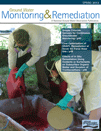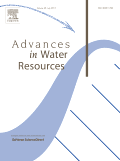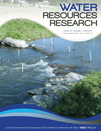
GROUND WATER MONITORING AND REMEDIATION
Scope & Guideline
Shaping the future of water resource management.
Introduction
Aims and Scopes
- Groundwater Contamination Assessment:
The journal emphasizes the assessment of groundwater contamination, including methodologies for identifying and quantifying contaminants such as PFAS, VOCs, and other hazardous substances. - Innovative Remediation Technologies:
A core focus is on the development and evaluation of innovative remediation technologies aimed at restoring contaminated groundwater and soils, including bioremediation, thermal treatment, and chemical oxidation. - Hydrogeological Modeling and Analysis:
The journal covers hydrogeological modeling techniques that aid in understanding groundwater flow and contaminant transport, including statistical and machine learning approaches. - Regulatory and Policy Frameworks:
Discussion on the regulatory aspects of groundwater management, including compliance with federal and state regulations, and the implications of new policies on groundwater protection. - Data Management and Technology Integration:
The integration of modern data management tools and technologies for groundwater monitoring, including sensor technology and data analytics, is a significant theme within the journal. - Community Engagement and Education:
The journal highlights the importance of community engagement in groundwater management and the role of educational initiatives in promoting better understanding and practices.
Trending and Emerging
- PFAS Contamination and Remediation:
Recent publications have highlighted a surge in research surrounding PFAS, driven by regulatory changes and public health concerns, focusing on detection, assessment, and innovative remediation techniques. - Impact of Climate Change on Groundwater Systems:
Emerging studies are increasingly addressing the effects of climate change on groundwater dynamics, including changes in recharge rates, contaminant transport, and the resilience of aquifers. - Integration of Advanced Technologies in Groundwater Monitoring:
There is a growing emphasis on the application of advanced technologies, such as UAVs, remote sensing, and real-time monitoring systems, to enhance groundwater monitoring and data collection. - Community-Centric Approaches to Groundwater Management:
An emerging theme is the importance of community involvement and stakeholder engagement in groundwater management, reflecting a shift towards more inclusive and participatory practices. - Biogeochemical Processes in Remediation:
Research focusing on the biogeochemical processes that influence the effectiveness of remediation techniques is gaining traction, especially in relation to natural attenuation and bioremediation strategies.
Declining or Waning
- Traditional Groundwater Sampling Techniques:
There is a noticeable decrease in publications focused on traditional groundwater sampling methods, as newer technologies and methodologies gain prominence in groundwater research. - General Groundwater Quality Studies:
Studies that broadly address groundwater quality without the application of specific innovative techniques or technologies have become less frequent, overshadowed by more targeted research. - Historical Case Studies of Groundwater Contamination:
While historical case studies are valuable, their prevalence has declined as the journal shifts towards more contemporary issues and innovative solutions in groundwater management. - Non-Contaminant Focused Hydrogeology:
Research that does not directly address contamination or remediation, such as purely geological studies of aquifers, appears to be diminishing in favor of applied research relevant to current environmental challenges.
Similar Journals

EQA-International Journal of Environmental Quality
Unlocking insights for a healthier planet.EQA-International Journal of Environmental Quality, published by the University of Bologna, Department of Agricultural Sciences, is a premier open-access journal dedicated to the multidisciplinary exploration of environmental quality issues. Established in 2009, it aims to foster a greater understanding of the intricate interactions between human activities and environmental health. With a focus on innovative research, the journal contributes to the advancement of knowledge across diverse fields, making it an essential resource for researchers, professionals, and students engaged in environmental science and sustainability. The journal operates with an emphasis on accessibility, ensuring that critical findings reach a global audience without barriers. With an impressive Scopus rank of 88 out of 171, EQA stands as a significant platform for disseminating impactful research that informs policy and promotes environmental stewardship.

ADVANCES IN WATER RESOURCES
Leading the way in hydrology and environmental stewardship.ADVANCES IN WATER RESOURCES is a premier peer-reviewed journal published by Elsevier Science Ltd, dedicated to advancing the field of water science and technology since its inception in 1977. With an impressive Q1 ranking in the field, this journal provides a vital platform for researchers, professionals, and students to disseminate cutting-edge research that addresses critical issues related to water resources management, hydrology, and environmental sustainability. The journal offers a comprehensive collection of articles that explore innovative methodologies, policy implications, and case studies that shape the future of water resource management. Although it does not provide open access, its impactful contributions are recognized globally, making it an essential resource for anyone engaged in water science. The journal continues to publish relevant research while looking forward to bridging the gap between theoretical insights and practical applications up until 2024.

WATER RESOURCES RESEARCH
Driving Impactful Discoveries in Water ResourcesWATER RESOURCES RESEARCH, published by the American Geophysical Union, stands as a premier journal in the field of environmental science, specifically within the domain of water science and technology. With an impressive impact factor and a categorical ranking of Q1 for 2023, it ranks within the top 10% of relevant journals, evidencing its critical role in advancing the knowledge and application of water resources research. Since its inception in 1965, the journal has been dedicated to rigorous research that addresses pressing global challenges related to water resource management, hydrology, and environmental sustainability. The journal's comprehensive publication scope aims to present innovative findings and methodologies that can shape effective policies and practices. Although it does not offer open access, the robust research it publishes continues to influence academics and practitioners alike, ensuring its position as an essential resource for anyone engaged in the pursuit of water-related knowledge and solutions.

Carpathian Journal of Earth and Environmental Sciences
Championing High-Quality Research in Earth SciencesCarpathian Journal of Earth and Environmental Sciences is a distinguished academic journal dedicated to advancing the interdisciplinary field of Earth and environmental sciences. Published by the Carpathian Association for Environment and Earth Sciences, this journal plays a pivotal role in disseminating high-quality research focused on the dynamic interactions between geological processes and environmental changes. With an ISSN of 1842-4090 and an E-ISSN of 1844-489X, the journal is indexed in Scopus and holds an esteemed Q3 quartile ranking in both Earth and Planetary Sciences and Environmental Science categories as of 2023. Since its inception in 2008, the Carpathian Journal has provided an open access platform for researchers, professionals, and students to share insights, foster collaboration, and engage in critical discussions on pressing environmental issues. By continuously contributing to the body of knowledge in this field, the journal not only enhances academic discourse but also promotes sustainable environmental practices across Romania and beyond.

Hydrology
Advancing water science for a sustainable future.Hydrology, published by MDPI, is a prominent open-access journal dedicated to advancing the field of hydrological science. Since its establishment in 2014, the journal has garnered a reputation for excellence, reflected in its classification within the Q2 quartile for 2023 across multiple categories including Earth-Surface Processes, Oceanography, Water Science and Technology, and Waste Management and Disposal. Based in Switzerland, Hydrology provides a vital platform for scholars and practitioners to disseminate research findings, promote innovative methodologies, and foster discussions on current trends affecting water resources and management globally. The journal is easily accessible online and aims to significantly contribute to the understanding of hydrological processes, offering insights that are pivotal for addressing contemporary environmental challenges. With Scopus rankings showcasing its growing influence, Hydrology is a crucial resource for researchers, students, and professionals committed to water science and sustainable practices.

Groundwater
Exploring the Depths of Hydrology and TechnologyGroundwater is a premier academic journal published by WILEY, focusing on the critical intersection of hydrology, environmental science, and technology. Established in 1963, this journal has a rich tradition of publishing high-quality research and reviews that examine the complex dynamics of groundwater systems, their management, and their role in ecosystems and human society. With an impact factor reflecting its relevance and rigor, Groundwater ranks in the Q2 category for both Computers in Earth Sciences and Water Science and Technology as of 2023, underscoring its significance in these fields. It is crucial for researchers, professionals, and students striving to stay at the forefront of groundwater research and management methodologies. By providing insight into both theoretical frameworks and practical applications, Groundwater serves as an essential resource for addressing pressing water resource challenges.

Groundwater for Sustainable Development
Transforming challenges into sustainable groundwater strategies.Groundwater for Sustainable Development is a distinguished peer-reviewed journal published by Elsevier, committed to advancing knowledge and practice in the vital field of groundwater management. With an ISSN of 2352-801X, this journal not only focuses on the sustainable utilization of groundwater resources but also explores the intricate relationships between groundwater and various environmental factors. Established in 2015 and converging through 2024, the journal has garnered a reputation for excellence, reflected in its impressive rankings: Q2 in Environmental Chemistry, and Q1 in several categories, including Environmental Engineering, Geography, Planning and Development, and Water Science and Technology as of 2023. Moreover, its Scopus rankings affirm its significance, with a remarkable position in the top percentiles of social sciences and environmental sciences. The journal serves as an essential platform for researchers, professionals, and students seeking to contribute to sustainable groundwater practices, ensuring accessibility to impactful resources and cutting-edge research that addresses contemporary challenges in water management.

Bulletin of Engineering Geology and the Environment
Exploring the intersections of geology and engineering innovation.Bulletin of Engineering Geology and the Environment, published by SPRINGER HEIDELBERG, is a leading journal dedicated to the fields of Geology, Geotechnical Engineering, and Engineering Geology. With an impressive impact factor placing it in the Q1 category for both geology and geotechnical disciplines, this journal is recognized for its significant contributions to the knowledge and application of engineering geology practices. Since its inception in 1984, the Bulletin has provided a platform for researchers and professionals to share cutting-edge research, case studies, and innovative methodologies relevant to the challenges of understanding and managing geological environments. With a robust Scopus ranking—#32/321 in Geology and #43/229 in Geotechnical Engineering—this journal is an essential resource for academics and industry leaders alike, striving to advance the environmental engineering field. For those interested in accessing the latest research and developments, the Bulletin fosters a collaborative and informed scholarly community.

Grundwasser
Fostering collaboration in the quest for groundwater solutions.Grundwasser is a prominent academic journal hosted by SPRINGER HEIDELBERG, dedicated to advancing knowledge in the field of water science and technology. With its ISSN 1430-483X and E-ISSN 1432-1165, the journal serves as a crucial platform for disseminating research findings, methodologies, and case studies related to groundwater management, hydrology, and environmental sustainability. Since its inception in 1997 and continuing through 2024, Grundwasser has established itself within the Q3 quartile of the Water Science and Technology category, as recognized by Scopus, ranking #164 out of 261 in Environmental Science. The journal emphasizes rigorous peer-reviewed content, aimed at fostering a deeper understanding of groundwater systems, their ecological implications, and the challenges posed by climate change. Researchers, professionals, and students are encouraged to delve into the latest studies and contribute to this vital area of environmental science, contributing to both academic knowledge and practical applications in groundwater sustainability.

VADOSE ZONE JOURNAL
Championing sustainable practices through open research.Vadose Zone Journal, published by Wiley, is a premier Open Access journal dedicated to advancing research in the dynamic field of soil science, particularly focusing on the vadose zone—the area of soil above the groundwater table that plays a critical role in hydrological processes. Since its inception in 2002, the journal has provided a platform for high-quality, impactful research, reflected in its impressive ranking among the top 25% of journals in the Soil Science category. With an increasing emphasis on sustainable agricultural practices and environmental protection, the Vadose Zone Journal offers invaluable insights and innovative methodologies that cater to the needs of researchers, practitioners, and students alike. Located in Hoboken, NJ, the journal operates on a fully Open Access model since 2018, ensuring that cutting-edge findings are readily accessible to a global audience. Join the community of experts and make significant contributions to our understanding of critical soil processes through this esteemed publication.